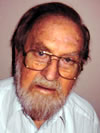 John W. Weymouth |
2012 Rip Rapp Archaeological Geology Award
Presented to John W. Weymouth
Citation by Mark Lynott and Rinita Dalan
The 2012 recipient of the Rip Rapp Award in archaeological geology is John Weymouth. John completed his Ph.D. in Physics at the University of California-Berkeley in 1951. Throughout the 1960’s, he explored the application of x-ray diffraction to archaeological ceramics. In the 1970s he shifted his research to the application of geophysical sensing techniques in archaeology. At that time, John was part of a small number of international scientists with training in physics that were working to develop instruments and methods that would help archaeologists locate subsurface features at archaeological sites.
John’s pioneering work, to use magnetometers as a survey tool for subsurface mapping of archaeological features, was conducted throughout the United States and Europe and demonstrated the essential need for geophysical surveys in advance of archaeological excavations. His most notable early contributions were magnetometer survey at Sakakawea Village at Knife River Indian Villages in North Dakota, and Walth Bay site at Oahe Reservoir near Mobridge, South Dakota. These important studies introduced North American archaeologists to the potential of geophysics for improving archaeological research.
Much of John Weymouth’s work has been in assistance to the National Park Service. He has conducted geophysical investigations on more than a dozen units of the National Park Service ranging from Fort Clatsop and Chaco Canyon to Abraham Lincoln’s Home and Hopewell Culture National Historical Park. His research has included work at important sites on St. Catherine’s Island, in South Carolina, Cahokia and Fort des Chartes in Illinois, Spiro, Deer Creek and Edwards in Oklahoma, and the Cowen site in Iowa. Dr. Weymouth has done important work on historic sites ranging from Fort William in North Dakota, Fort Atkinson in Nebraska, to Fort Davidson in Missouri and Fort Larned in Kansas. He has worked on historic Indian village sites, pioneer farmsteads, and the Rock Creek Station on the Oregon Trail. Although Dr. Weymouth began his research with a focus on magnetic surveys, he has also incorporated resistivity and ground penetrating radar into his arsenal of skills and continually refined these techniques, pioneering their use in wide range of prehistoric and historic contexts in North America, Europe and Japan.
Dr. Weymouth’s most recent work has been the mapping of a major Ohio Hopewell earthwork with a cesium gradiometer. His work has demonstrated the importance of geophysics for re-mapping and relocating prehistoric earthwork sites that have been severely degraded by two centuries of agriculture. Dr. Weymouth’s work has inspired the efforts of younger scholars to learn about the use of geophysics in archaeology and his efforts have transformed geophysical prospection in North America from a type of special analysis to an invaluable and standard component of contemporary archaeology. He has consulted with countless archaeologists and repeatedly demonstrated the important role of geophysical prospection in archaeological research.
In sum, Dr. Weymouth’s ground-breaking work paved the road for geophysical applications in archaeology. His meticulous and prolific studies demonstrated the usefulness of these techniques for a wide range of prehistoric and historic sites and inspired others to follow in his wake. He served as a bridge between the geophysical community and archaeologists, establishing and encouraging connections with archaeological practitioners on a national, but also on an international, level. He served as both teacher and scholar in developing geophysical techniques for archaeological application, working closely with National Park Service staff, mentoring students at University of Nebraska-Lincoln and elsewhere, and collaborating with many archaeologists and geophysists. He taught archaeologically-oriented geophysical classes at UNL, participated in numerous archaeological field schools, and was also an instructor for annual National Park Service training courses in remote sensing; in all these ventures retaining a firm commitment to technical precision and expertise. He presented his findings at archaeological, geological, and geophysical conferences and through publications and technical reports produced an unparalleled body of work spanning four decades that researchers continue to learn from.
 2012 George (Rip) Rapp Archaeological Geology Award — Response by John W. Weymouth
2012 George (Rip) Rapp Archaeological Geology Award — Response by John W. Weymouth
Being honored with the Rip Rapp Award by the GSA is like being given the cherry on top of the confection since I have so thoroughly enjoyed working with archaeologists on interesting sites. Back in the early 70’s I was contentedly teaching Physics and doing research in materials science when archaeologists of my acquaintance at the University of Nebraska challenged me with some science problems in their discipline. Out of my reading, talking and thinking on these problems I developed a seminar course in “Science in Archaeology”. With such a broad title we could study a wide range of applications. I did some research in x-ray diffraction of ceramics but it became clear that there was a need to develop tools and field expertise in evaluating sites being considered for excavation. The literature showed me that magnetic surveying of sites had been pioneered in Europe and should be able to be used in this country. There followed years of development of instruments and field work at various sites in this country and in Japan and Greece. Working with a wide variety of archaeologists and students has been very satisfying. It is especially gratifying that one of my PhD students is now a professor of Physics teaching and working in magnetic prospection in Greece on Crete.
I wish, particularly, to thank Drs. Rolf Mandel, Mark Lynott, Rinita Dalan and George Rapp for their input to this award and to thank in general the many others with whom I have had the privilege to work and agonize over data and equipment breakdowns. The award helps to emphasize the importance of applying geophysical methods to investigation of sites and to encouraging the wider use of such methods to extend sound site evaluation.
Thanks again to George Rapp for creating this award to encourage interdisciplinary efforts across the barriers that sometimes seem to isolate areas of research.
